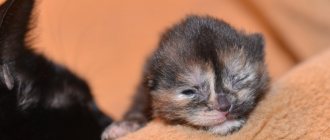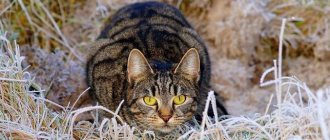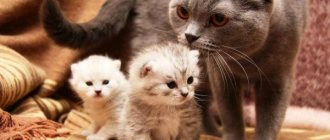As a rule, cats are very good mothers. How could it be otherwise, because they are very tiny and do not know how to do anything themselves. Kittens are born deaf and blind, and the only thing they instantly understand is how and where to get their first milk. They all rush straight to mommy. Kittens are born with an excellent sense of touch and smell.
- 1 Development of a kitten in the first week 1.1 Feeding in the first week
- 4 4 weeks
- 5 Week 5
- 6 Development of a kitten at 5-6 weeks
- 7 2 months
At what age can you tell the difference between genders based on behavior?
Newborn kittens, photos of which can be seen in the article, are no different from each other in terms of characteristic manifestation. They are all cheerful, active, mobile, and develop equally. In some cases, males may weigh more. This is especially noticeable in representatives of large breeds, such as Scottish Folds (photos of newborn kittens are presented below).
It is easy to determine the sex of a pet by behavior at an older age, when its character is formed, puberty sets in, and it becomes accustomed to the environment. This happens at 5-7 months of life. It is enough to observe the animal for some time for everything to become clear:
- Cats are more active and independent. They are not so much interested in family members as in hunting and protecting their own territory. They are fond of playing with small objects and love to watch moving objects outside the window. If another pet appears in the house, the cat will jealously fight for its territory. Among other things, female cats are distinguished by great cleanliness and constantly lick their fur.
- Cats behave differently. They make more contact with people, are friendly and affectionate. Most often, males are lazy; they like to bask in the sun or sleep in a soft bed. However, representatives of some breeds are playful.
When the moment of mating comes, cats mark the territory, which cannot go unnoticed due to the unpleasant smell. The animal's character changes dramatically and, if you don't let it go for a walk, it can scratch or bite its owner. In turn, cats emit loud screams at any time of the day or night, while becoming more affectionate.
Sixth month
By the age of one and a half months, a kitten, like a real adult animal, knows how to wash itself, hunt, go to the litter box, if accustomed to this, and eat solid food.
It’s still too early to separate the baby from his mother, who will teach him all the intricacies of a cat’s life.
The little pet has already learned to let out its sharp claws, so it’s time to think about a scratching post.
The eyes are clear, vision is sharp, movements are coordinated and precise, but childish clumsiness is still visible.
You need to feed the kitten 5 times a day, the food should be as varied as possible. At the same age, the kitten is taken to the veterinarian so that he can examine the baby and draw up a vaccination schedule.
At this time, you need to closely monitor your pet’s secretions for parasites. If pests are found, you should immediately contact a veterinarian. Now the baby practically does not drink mother's milk and needs almost complete nutrition. It is necessary to feed the kitten six times a day, giving one hundred grams of food per meal. This is the age at which the baby simply needs love and care. Also try to protect your pet from stress.
We suggest you read: How to toilet train a pug puppy
It is also time to carry out primary prevention of cat diseases. Now it is necessary to constantly examine your pet. To make it easier for the fluffy to survive separation from his mother, try to bring objects that are familiar to him into his habitat. Let your pet explore its territory on its own. The main thing is to protect it from chemicals, small objects, poisonous plants and electric current.
By this age, the animal has grown to its adult size. Now the pet's puberty begins. So if you are planning to castrate your pet, then it is best to carry out this procedure for up to a year, and for a female individual up to eight months. A six-month-old animal's meals are reduced to three times a day.
You have to finally make the decision to sterilize your cat, since this is the age limit after which the animal will begin to develop sexual habits.
How to find out gender at a very early age by external signs
It is easiest to determine the sex of a newborn pet (see photos of kittens in the article) immediately after its birth. The fur at this time is still wet and has not straightened out completely. When the baby becomes furry, it becomes more difficult to determine gender.
Newborn kittens (owners often keep photos of funny babies in albums) have two excretory canals under their tails. The first is for the exit from the rectum, the second is for the exit of the urinary system.
First, you should carefully consider how they are located on the kitten. The distance between these exits in cats is about one centimeter. This is where the pet's scrotum is located. In a female, this value does not exceed three millimeters. These holes differ in shape among different sexes. In cats they are elongated, in males they are round or oval. Simply put, you can see a pronounced “colon” under the male’s tail, while the female has something similar to an inverted exclamation point.
At 10 days of age, cats experience hair growth between the anal and genital openings. In cats, this area is practically devoid of hair. If the pet is a furry breed, it will be quite difficult to determine its gender based on this characteristic, since every day the fur covers the excretory canals more and more.
Third week of life
Once children reach this age, they should begin to wash themselves. You definitely need to keep an eye on this. Since this is an important moment in training a pet. Now babies suckle little at their mother's breast, as the cat spends less and less time with them. This is a time of changes in the baby’s established rhythm of life, which are not always pleasant for the kitten.
If your pet has reached a weight of two kilograms, then it should be transferred to four meals a day. You can combine wet and dry feeding, or stick to one method.
How to find out the gender of an animal older than a month
At this time, the genitals of pets are already more pronounced. In cats you can find the foreskin and testicles, in females you can find the anus and a narrow slit. Before deciding on the choice of a pet of a specific gender, they look under the tail to determine it.
The use of this method for recognizing the gender of a newborn kitten (photos of babies are presented in the article) is considered the most reliable. The probability of correct identification is 90%.
Kitten nutrition
- up to 2 months – 5 times;
- by the age of six months, the frequency of feedings gradually decreases to 3 times, and the portion gradually increases;
- An eight-month-old animal is fed like an adult - twice a day.
Your pet's diet must include:
- raw beef;
- boiled chicken meat;
- milk porridge;
- egg yolk;
- raw and boiled vegetables;
- fermented milk products.
You cannot feed food from the human table: salt and spices are harmful to the cat’s body.
How to wash a cat's eyes at home: pharmacy and folk remedies, when required
Veterinarians recommend purchasing balanced cat food for kittens, taking into account age. Specialized mixtures contain all the necessary elements necessary for the growth of a pet.
How to hold a kitten
To avoid injury and stress in the newborn, a visual inspection is carried out as follows:
- The kitten is taken in the palm of your hand and warmed up for several minutes, allowing it to calm down.
- Then carefully transfer it to a dry, soft surface on the tummy or back.
- Then they carefully lift or move the tail to the side and examine the genitals.
If you scratch or massage the animal's rump a little, it will instinctively raise its tail. You should not disturb the kittens by carrying out this procedure if their mother is restless, otherwise she will begin to drag the babies from place to place, trying to cover them. If it was not possible to immediately determine the gender, it is better to try again the next day. Kittens quickly become hypothermic without maternal warmth, so examination should be done as quickly as possible. As a last resort, the genitals can be photographed, and then the gender can be determined without haste. You can see what newborn kittens look like in the photo below.
Cat menu
Owners who feed their pets natural food should remember that cats need a high-protein diet and, compared to dogs, are more carnivorous.
The kitten's diet should include the following products:
- Raw veal or lean beef , frozen for two days and cut into pieces, is fed daily.
- Chicken or turkey meat , frozen for two days and cut into pieces - served 3-4 times a week, provided there are no allergies.
- Beef offal (liver, lungs, kidneys, heart, udder) - given boiled, cut into pieces. Excess liver and fatty udder in the diet can cause loose stools. The kidneys are pre-soaked in running water.
- Chicken and turkey livers and hearts , boiled and cut into pieces, are allowed 2-3 times a week, provided there are no allergies.
- Heads and necks of broiler chickens - given raw 1-2 times a week as a source of natural minerals and for training chewing muscles. The beaks must be removed and the heads cut into two parts. The necks can first be beaten with a kitchen hammer, crushing the vertebrae so that the spongy bones do not get stuck on the kitten’s sharp teeth and injure the gastrointestinal tract. You can give 1-2 heads or necks at a time.
- Boiled sea fish fillet – 2-3 times a week. More frequent feeding of fish shifts the mineral balance of the body towards phosphorus, and with prolonged consumption of raw fish, the development of B1-vitaminosis and chronic iron deficiency is possible.
- Oatmeal or rice porridge , boiled in water, are given daily.
- Chicken egg yolk – served raw or boiled 1-2 times a week.
- Unsweetened and unsalted cottage cheese , which has a low fat content, is fed every other day.
- Soft unsalted and low-fat cheese , cut into pieces - up to 2-3 times a week.
- Fermented milk products (unsweetened yogurt, kefir, yogurt, fermented baked milk) - if well tolerated, can be given 2-3 times a week.
- Vegetables – if the animal likes them, serve them raw or boiled.
Production ration. Kittens kept on dry food and canned food are fed in accordance with the norm indicated on the packaging. You should choose super premium food, for example:
- Royal Canin Kitten;
- Orijen Cat & Kitten;
- Acana (kitten range);
- Pronature Original Kitten;
- Bosch Sanabelle Kitten.
Pets who love to chew something are offered all kinds of chewable treats from the pet store in addition to their daily diet.
What not to do
Photos of newborn fold-eared kittens are touching pictures that you can look at endlessly. Despite this, there is no need to disturb the kids again. You should also follow some rules:
- You should not tear your pet away from its mother while feeding.
- You cannot lift a kitten by its tail.
- If possible, you should try not to touch the babies until they reach three weeks of age. Some cats, sensing a foreign smell, abandon the baby.
- It is prohibited to put pressure on the genital area during the examination.
Seventh week
At this age, breastfeeding usually ends. So pay close attention to ensure that your baby does not have stomach problems. If you observe symptoms of a stomach disorder, you should immediately contact a specialist. Now the baby’s diet necessarily consists of six meals a day.
The first seasonal molt begins. Be prepared for your pet to vomit hairballs frequently. However, if you brush your pet in a timely manner, there will be significantly fewer such incidents.
We recognize affiliation by face and DNA
You can recognize the sex of newborn fold-eared kittens (photos of these fluffy pets are presented below) by carefully examining their face and body. This method is more suitable for experienced owners. Those who are dealing with representatives of the feline family for the first time may make a mistake.
Females have a more elegant, elongated and narrowed muzzle. In turn, cats are endowed with a large head and a muscular body. The disadvantage of this method is that it is only possible to determine sex in adult cats, when the characteristic features are more pronounced.
Modern medicine makes it possible to accurately determine the sex of kittens at any age using a DNA test. Conducting this research will require significant financial expenses. However, if the animal has reached three months of age since birth, there is no need for testing.
The study can be carried out in a veterinary clinic equipped with appropriate equipment. The DNA testing method is used primarily by owners of breeding animals who breed and sell them. During the test, a sample is taken from the inside of the kitten's cheek. As a result, it is possible to identify not only the gender of the pet, but also its susceptibility to certain genetic diseases.
How to care for a kitten at home
The formation of the body, health and life expectancy of an adult cat depend on proper care in the early period of life.
Caring for newborn kittens
If the babies are with a cat, then the mother takes care of the offspring and the owner has few worries.
Need to control:
- "Nest" state. Clean the litter from wool and dirt.
- Weight gain. Newborns weigh approximately 120 g and, with normal development, gain 100 g weekly. Kittens grow a little faster than female cats. If the baby is growing more slowly, then he needs to be shown to the veterinarian.
- Condition of fur, eyes and ears. The coat should be dry and clean, and there should be no discharge from the ears and eyes. The cat's mother licks her offspring and healthy babies are always clean.
On the 8th day, the eyes open, by the end of the second week the babies begin to hear, and on the 20-21st day the kitten tries to walk.
There is no need to worry about newborns: the babies eat and sleep, actively gaining weight.
As soon as the baby opens its eyes, stands on its paws and begins to show interest in the world around it , the kitten needs to be picked up and stroked. Positive human contact will help the animal grow up affectionate and playful.
Care at 1 month
At this age, it is better not to take the baby away from its mother.
But if for some reason a month-old kitten is alone, then it will require special care:
- Feeding. The main diet should be milk. It is better to purchase a cat milk substitute at the veterinary store or dilute the dry milk by adding a little honey or sugar. Complementary foods (meat, porridge) are added in small doses. New food should be given in small quantities so as not to cause intestinal upset. You need to feed 6 times a day.
- Providing peristalsis. The cat licks the baby's tummy, stimulating intestinal function. To help the pet, the owner needs to moisten a cotton pad with warm water and massage first the sides and then the tummy in a circular motion from the sternum to the groin.
- Fresh water. If food is given on a schedule, then water should be in the bowl at all times.
Reasons and ways to suppress a cat’s aggression and calm the animal down if it gets angry, meows, cries before bedtime
The animal must be toilet trained immediately. If the kitten begins to worry and “look for a place,” then you need to take it and put it in the tray.
You need to be persistent if the baby tries to run away and refuses to “do his business” in the designated area. The procedure must be carried out several times until the small pet understands where to defecate.
If your pet refuses to go to the litter box, then perhaps he is frightened by the large granules of the filler or does not like the consistency. By changing the toilet filling, you will be able to cope with the problem.
At this age, you should begin to accustom long-haired kittens to brushing. It is better to purchase a soft brush that detangles the fur and does not scratch the skin: then the combing procedure will be perceived as a pleasure by your pet.
This is interesting: What to do if a cat twitches in its sleep?
How to find out gender by coat color
The color of a cat's baby can also indicate its gender. In this case, newborn kittens can be distinguished by gender (photo below) taking into account the following features:
- The tortoiseshell color combines three colors - black, white and red. As a rule, its owners are female representatives of the cat family. This fact is due to the transfer of color by the X chromosome, and for the manifestation of all three tones, a pair of them is needed. Only cats have them in such quantity; males have only one X chromosome. In nature, tortoiseshell cats are found only if they are susceptible to rare genetic diseases.
- Mainly males are distinguished by their red color. If a born kitten has this color, there is a 99% chance it will be a boy, but there are exceptions to the rule.
If we talk about the thickness of the fur, it differs only in the location of the genital organs - males have much more of it, but in females it is almost completely absent.
The third week of a kitten's life
In the 3rd week of life, babies gradually get tired of endlessly lying next to their mother cat. Kittens' vision improves every day, as a result of which they become bolder and more adventurous. This is how play time begins. Out of curiosity, one kitten timidly pushes the other with its paw, receives a couple of kicks in response, throws its entire two-hundred-gram body at its neighbor - and the first fight breaks out between the kids.
For a long time, kittens do not get much of what they would like. They are no longer as helpless as before, but they are still infinitely naive and very clumsy. Having no life experience, they need the help of their mother cat, in particular during the first forays out of the nest and finding their way back to their mouths. Indeed, in this case we are talking about random attempts to explore uncharted spaces, where only cold, loneliness and fear often await the baby. Fortunately, hearing the plaintive meow of one of her offspring, the mother cat immediately rushes to his aid.
The mother cat no longer needs to help the babies with the processes of digestion and bowel movements. Over 3 weeks, the little bodies of the kittens gradually get used to coping with this task on their own. And in exceptional cases, the cat is still ready to come to the aid of the suffering offspring and give him a tummy massage. If you wish, you can take an example from your pet and help the kids by periodically stroking their bellies in a circular motion.
Animal size and folk methods of determining ownership
You can often find out the gender of a newborn kitten (the photo below demonstrates this well) by size and weight. As a rule, females are smaller than males, more graceful and graceful. However, based on these signs alone, it will not be possible to determine with one hundred percent probability the gender of a newly born pet.
One of the popular methods says that if a kitten looks around warily and is rather indecisive, it is most likely a female. Cats, on the contrary, are characterized by courage and self-confidence. However, this rather depends on the nature of the animal.
Another method of determination is based on the pet’s habits. A bowl of food is placed in front of him and his behavior after feeding is observed. If the tail is raised up, it is a cat; if it is modestly lowered, it means a cat.
Second week of kittens' life
At the 2nd week of life, kittens' eyelids open, allowing them to take their first look at the world hidden behind them. The kittens' still cloudy eyes gradually get used to the light. It will take about 2 more weeks until the babies can see everything clearly, but for starters, the sight of their brothers and sisters and the warm mother’s nipple is enough for the kitten. This event is followed by a series of amazing transformations. The kitten's ears rise so that their sharp tips become visible. Baby teeth begin to emerge. After a few days, babies can already scratch, bite, hiss threateningly and raise their fur quite painfully. Their senses become sharper, and they become more and more inventive, especially in terms of various pranks. And by the end of the 2nd week, the kitten can confidently stand and move on its paws. So, almost overnight, a small helpless lump turns into an active, playful kitten.
Male kittens are usually much more active than their sisters. Having not yet learned to stand on straightened paws, they are already beginning to push and push each other. Apparently, such fussing of little males is an important part of their preparation for adulthood. It is noteworthy that cats almost never have offspring consisting only of females. Scientists believe that in the case where there is a lack of males among the embryos, nature itself intervenes and, with the help of hormones, even at this stage of development, turns one of the future cats into a cat.
However, the largest kitten is not necessarily born a boy. After all, that's it. How much milk someone gets does not depend on the gender of the babies. Often the kitten remains faithful to the nipple that he managed to grab on the first day of life. It’s interesting that almost all yard kittens do this, but purebred kids do it only occasionally. Scientists do not yet know what explains this feature. Perhaps the reason that babies are able to recognize “their” nipple at all lies in their good sense of smell. However, scientists believe that kittens simply remember where and between whom they lay when they first fed.
other methods
If it was not possible to distinguish newborn kittens by gender (see photo in the article) while they are very small, you should wait until the babies are a little older. In the end, if a new family member has won the heart of the household, what difference does it make whether he is a male or a female? Photos of newborn kittens - Persian, Siamese or any other breed - prove that it is impossible not to love these babies. If gender is of fundamental importance, you can try to determine it in the following ways:
- A tricolor kitten is most likely a female. Cases of the birth of tortoiseshell cats are considered an anomaly. In addition, they end up being infertile.
- It is extremely rare to find a red cat; as a rule, they always turn out to be cats.
- Male representatives of this family behave unceremoniously, are very active and lively.
- Cats are more careful, calm and leisurely.
- Males have sharp and large features, while females have a more subtle and smooth muzzle.
- Cats have a narrower chest and thinner paws. Males, on the contrary, are larger and stockier.
- The urine of cats has a sharp and unpleasant odor, unlike cats.
Of course, many of the listed methods for determining gender raise some doubts. They are indeed not very accurate, however, they can be used in conjunction with other, more reliable methods.
How to care for kittens without a cat
The owner will have to replace the kittens' mother:
- Heating. A heating pad with water heated to a temperature of 35°C, on which a soft mattress is laid, works well. It is not recommended to place newborns near heating devices or warm them with an infrared lamp. In the first case, this will cause overheating, and the use of lamps may affect vision when babies open their eyes.
- Feeding. It is better to buy a cat's milk substitute, but if this is not possible, you can use cow's milk, adding a pinch of sugar. It is important not to feed formulas with a high percentage of fat in the first weeks. To give food, use a bottle with a nipple or feed with a pipette. Dishes are washed and sterilized after each meal. Feeding is carried out at intervals of 2-2.5 hours.
- Hygiene. To maintain cleanliness, the baby's fur must be wiped with a damp cloth. Bathing at an early age is prohibited. The ears are cleaned from accumulations of wax with a cotton swab, and to care for opened eyes, it is recommended to take an eye wash from a veterinary pharmacy.
- Stimulates digestion. After each meal, massage your tummy and sides in a circular motion from the chest to the perineum.
At what age can a kitten’s claws be cut: why is it necessary, how often, description of the procedure
By the third week, kittens will begin to walk. In addition to feeding and care, you will need to pay attention to education: toilet training, showing a scratching post.
Kittens grow quickly and what is developed in the first days and weeks of life will become the basis for the behavior of an adult animal.
Development in the first week of life
Newly born babies weigh no more than 100 g, but already in the first week of life they practically double their weight. Too much or too little of this value directly affects the development of the animal, so it is important to provide careful care and weigh it regularly.
After 3-5 days, the kittens’ umbilical cord falls off, and the mother cat takes care of it independently. To exclude possible inflammatory processes, it is first recommended to lubricate it with a weak manganese solution.
Newborn kittens (photo below) are born blind and deaf. Deafness disappears already on the fifth day, vision appears only after three weeks. It is very important to properly arrange a place for a cat that has given birth, so that babies can easily find her by smell.
Development in the first weeks of life is rapid. It is at this time that kittens receive a complex of necessary vitamins and minerals from their mother’s milk to form a strong immune system.
Why monitor the development of newborn kittens?
It is very important to monitor how newborn kittens develop and know how best to care for babies at different stages of their growth. This will help get rid of many problems associated with animal health.
During the first three weeks of kittens' lives, mother cats themselves feed and care for them. However, control over the full and timely development of small pets is the responsibility of the owner. To do this, you need to regularly weigh the kittens, and also know when they open their eyes, when their first teeth are cut, when they begin to hear, walk and eat solid food.
Mother cat takes care of newborn kittens herself
What happens from the second to the fourth week
At the initial stage, the kitten's weight increases to 250 g, he begins to hear the call of his mother and the meowing of his brothers and sisters. At this time, the active development of the animal’s character begins.
In the third week, the babies' eyes open, but their vision is still quite poor. All organs of smell and touch continue to form, the skeleton is strengthened, and teeth appear. The jaw will not fully develop until two months of age. At this time, you can take the kittens in your arms, accustoming them to human care.
By the end of the fourth week, the animal already has 26 teeth, is able to move independently on straight legs and can switch to complementary feeding. During this period, changes in appearance occur less clearly, the kitten continues to grow and gain weight.
Stages of kitten development by month
The stages of growth and maturation of a kitten, from the moment of birth to one year, are associated with certain patterns. All kittens go through the same stages of development over the course of days and months.
First week
Kittens are born with their eyes closed and hear almost nothing. They are covered with light fluff; the most important thing for them during this period is warmth and milk.
In the first weeks, kittens' immune systems are largely supported by mother's milk. It provides their body with the proteins necessary for development. The weight of newborn kittens rarely exceeds 100 grams; within a week they gain weight from 10 to 30 grams per day.
Most of the day, approximately 90% of the time, kittens sleep. They move only to crawl to the cat for milk and warmth. If they are cold or want to eat, they call the cat with a loud squeak.
Kittens are born with primary reflexes
Observing the development of small kittens day by day, it can be noted that on days 5-8 kittens develop hearing. Since kittens are just learning to respond to sound, the room where they are should be relatively quiet.
After the 5th day of life, the umbilical cord dries out in kittens. The cat should constantly lick the cubs, giving a tummy massage, which helps stimulate the intestines.
There should be no drafts in the room where the cat and newborn kittens are located. If it is very cold, you can put a heating pad in the bed. Young kittens are very vulnerable to disease and infection.
Second and third weeks
On days 7-10, the eyes open. The process can take 2-3 days - at first there are narrow slits through which only the outlines of objects can be distinguished. The eyes are cloudy, blue and covered with a film. The eyes open completely by the 14th day.
Kittens' eyes open at 7-10 days
The speed of eye opening depends on several factors:
- by breed;
- from gestation period;
- on the health status of the mother and kittens.
In most cases, short-haired breeds develop faster than long-haired ones, and Oriental cats develop much faster than other cat breeds. For example, sphinxes (Canadian, Don) are often born with their eyes already slightly open, and on the 2-3rd day the eyes open completely. Siamese, Thai and Cornish Rex cats become sighted on days 3-6, Siberian and Persian cats on days 5-9, and British cats on days 6-10.
Another indicator is the gestation period of the kittens. If kittens are born at 68-71 days, then perhaps they will be born with their eyes already open, or will open them in a much shorter time.
If the kittens are healthy, eat well, and the cat devotes enough time to them, then the eyes, as a rule, open in a timely manner. A delay may indicate that the mother cat has some kind of virus, or that the kitten has developmental disorders. If more than 10 days have passed and the eyes are still closed and there is some discharge from under the eyelids, you need to consult a veterinarian.
In 2-week-old kittens, the fur grows and becomes thicker, and the undercoat begins to grow. At this age, kittens' susceptibility to temperature changes decreases, however, they are still vulnerable. The kittens' weight doubles. They hear much better, but still have difficulty identifying the source of sound.
A kitten at the age of 3 weeks continues to actively gain weight; its vision is not yet so sharp, so when it crawls, it can bump into objects. In the third week, the kittens make their first attempts to get out of the bed. During this period, baby teeth begin to emerge.
Three-week-old kittens begin to move actively
Kitten at 1 month
At 4 weeks of age, kittens begin to interact more and lick each other's fur. They begin to actively run, play, and adopt the skills of their mother. At this time, you can place a tray next to the bed on which the kittens sleep so that they begin to get used to it.
By the age of one month, the kitten has 26 milk teeth and sometimes bites the cat's nipple, causing pain. If maternal feeding stops by the age of one month, it is advisable to purchase a cat's milk substitute, since the kitten's body is not yet fully formed. At this stage, complementary foods and clean water are also introduced into the diet.
The bones of one-month-old kittens become stronger, they can already be picked up, stroked and played with more often so that they begin to get used to the person and his smell. This is also a good time to prevent worms.
By the age of one and a half months, the kitten already knows how to wash itself, hunt, go to the litter box, and eat solid food. At this time, you can purchase a scratching post, as the kitten begins to produce sharp claws.
Development of a kitten from birth to 1.5 months
Kitten at 2 months
Upon reaching the age of 2 months, kittens usually stop receiving mother's milk and switch to self-feeding.
At 2 months, kittens’ vision is fully formed, hearing and sense of smell are well developed. The kittens' eyes cease to be cloudy and acquire their natural shade. However, there are specific breeds in which the eye color does not change, for example, Siamese, Thai, Polynesian and British breeds.
The fur changes color intensity, the pattern appears, the lines become clear. This happens slowly and gradually, and therefore is not immediately noticed by others.
During this period, the kitten should be shown to a veterinarian for the first time, who will record the level of development and health status of the animal. At the age of 2.5 months, the kitten must receive its first vaccinations against viral diseases. The second vaccination is given after 3-4 weeks.
Two months you need to take the kitten to the veterinarian for examination and vaccination
Kitten at 3 months
In the third month of life, all processes begin to slow down a little, and the kitten’s character begins to emerge. He becomes completely independent and responds to his nickname.
A three-month-old kitten has a well-developed musculoskeletal system; he already knows where the bowl is and where the tray is. At this age, the kitten becomes faster and bolder. He is actively exploring his home, so it is necessary to ensure his complete safety. You should protect the kitten from chemicals, detergents, medications, poisonous plants, remove small objects - needles, pins, push pins, close electrical outlets.
A booster vaccination can be given at 12 weeks of age. At this time, it is also necessary to carry out repeated deworming, provided that it was first carried out at the age of 4-6 weeks.
By 3.5 months, the kitten’s character has already been formed, it sees and hears excellently, eats natural or industrial ready-made food, and goes to the litter tray. You can already visually distinguish a cat from a cat.
If you plan to give away or sell a kitten, then the age of 3-3.5 months is an ideal option for changing the owner.
You need to play with a small kitten every day
Kitten at 4 months
At 4 months, a kitten is already considered a teenager. During this period, his claws are trimmed for the first time and he is taught all hygiene procedures. To maintain proper development, you need to spend as much time as possible playing with the kitten; it is recommended to pick it up more often, show care and groom it daily so that the kitten feels comfortable when communicating with a person.
Milk teeth in kittens begin to change to molars; this happens gradually and often unnoticed by the owner. Kittens swallow most of their baby teeth with food.
At 4 months, a kitten needs to have its nails trimmed for the first time.
Kitten at 5 months
At 5 months, the kitten’s appearance gradually changes, its body increases in size, its muzzle and tail lengthen, its legs stretch. He already looks more like an adult cat, he is less interested in toys, he sleeps more and strives to communicate with people.
Sixth month of life
At the age of 6 months, the kitten reaches its adult size. Most kittens begin puberty during this period. The timing of puberty can shift from 4-5 months to 11-12 months of age. Puberty is affected by:
- Breed. Siamese, Thai, Burmese, and Oriental varieties ripen earlier.
- Season. In cats that reach 4-6 years of age in the spring and summer, puberty occurs earlier than in cats of the same age in the winter months.
- Maintenance and nutrition. Comfortable conditions and regular nutritious food help the pet mature faster.
- Habitat. Cats living with other adults of both sexes mature earlier than cats living in a city apartment.
At approximately 6 months, kittens begin puberty.
When a kitten reaches puberty, hormones change its behavior. The cats behave restlessly and rush around the apartment. Cats may become more aggressive. For this reason, it is important to consider spaying and neutering cats.
If offspring are undesirable, then girls should be sterilized at 6-8 months, boys should be castrated at the age of six months to a year. After the operation, the kitten’s body produces fewer sex hormones, and the animal loses the ability to reproduce.
If you decide to get offspring, then you should remember that physical and puberty are not the same thing. Regardless of the timing of puberty, the kitten’s physical maturity occurs no later than 10-12 months of age. It is during this period that you need to plan your first mating.
Kittens at 7-8 months
At 7 months, in autumn-winter, kittens begin their first molt. Because kittens lick themselves frequently during shedding, a large amount of hair accumulates in their stomach. To prevent this process, it is enough to regularly comb the coat with a soft brush.
Brush your kitten's fur regularly
From the age of 8 months, kittens practically do not gain weight, their growth does not noticeably increase. They have established habits. The characteristics of temperament are clearly visible.
Development from 9 months to 1 year
At 9 months, the kitten is fully formed, its development is almost complete, and it continues to grow into an adult, increasing in size and gaining weight. By this time, the regime has stabilized, the pet finds time to sleep and play.
At 10 months, a kitten is considered sexually mature. But mating before a year should not be carried out. The size of the cat at this time is already significantly larger than the size of the cat; these differences can be more than 1 kg.
At 11 months, most kittens stop growing. At 12 months, the kitten already looks like an adult animal. By this time, it is necessary to complete all vaccinations during the first year of life, castrate or sterilize, and switch to food for adult animals.
Development from month to year
Starting from this age, the gastrointestinal tract of kittens is actively developing; already in the eighth week, weaning from the mother occurs and the transition to independent food five times a day occurs. Deworming is carried out.
At three months, pets begin to look for a new owner. Parting with the mother and other kittens is not so painful if you devote enough time to the baby. Repeated deworming is carried out and the kitten is trained to use the tray.
Up to six months of age, the animal continues to eat kitten food. At six months, the pet’s teeth begin to change, and he is transferred to three meals a day. According to experts, this time is optimal for castration. The third deworming is performed.
At seven to eight months, cats continue to develop self-care skills. At nine months of age, the pet is considered fully formed; it continues to grow and gain weight. It is important to monitor the condition of the animal’s nails and cut them in a timely manner. During this period, they begin to gradually transfer the pet to food for adult cats, gradually mixing it into their usual food.
By the age of one year, the pet has completely completed its development. He is accustomed to go into a litter box or outside, has all the necessary skills of an adult animal, and has an established and formed diet. It is important to visit a veterinarian promptly for vaccinations and monitoring the health of your pet.
Fifth week
At the age of 40-45 days, kittens undergo the first deworming. It is important to purchase medications for kittens, as they contain the appropriate dosage. If you had a planned mating through a referral club, then after 45 days of age you should either invite a specialist from the club or go with your cat and kittens to the club for octation.
Kittens will be examined for compliance with breed data, for health status and, as a result, kitten cards will be issued, and the data will be entered into the stud book.
Beginning of the second month of life
In the fifth week, the crumbs become simply unrecognizable. It seems that these “hooligans” have nothing in common with those motionless babies who were located in the nest about a month ago: they already run deftly, improve their sense of balance, can bypass obstacles, sneak up from behind and attack. By this time they are already showing concern for each other.
5 weeks is a turning point in the kitten’s nutritional system. At this age, you can try offering him complementary foods. The ideal supplementary diet (the main one is still cat milk) is canned food for kittens.
Kittens at three and four weeks of age
By the beginning of the third week, small fluffy balls usually begin to emit the first purr, the picture of the visual field of any kitten becomes definite: visually they will already be able to find their mother. After a week, the development of the organs of hearing and smell ends, and the ears take shape. In addition, kittens at the age of 3-4 weeks take their first hesitant steps and pay attention to their sisters and brothers. At the same time, their baby teeth appear, the incisors emerge first, followed by the canines, premolars and molars.
At 4 weeks, you don’t have to worry about the fact that it’s too early to introduce your young pet to the toilet. It is advisable to take care of the baby and, just in case, purchase a litter tray designed for kittens. They often perceive it either as food or as a toy. Ordinary contents of the litter tray may be harmful to the animal if swallowed (for example, silica gel).
Toys and other things for development and communication with a kitten
All children love to play, and felines are no exception. Having settled in a new place, the baby begins to enjoy running after a piece of paper on a string or chasing various objects across the floor.
It is better to make sure that the kitten has its own things:
- Movable toys. Fur balls, rubber mice and other similar things. It is important that toys do not have small parts: kittens are teething, the baby can bite off a small part and choke.
- Hanging objects. A ball hanging on a thread on the door handle will occupy the attention of a cat child for a long time.
- Scratching post. Sharpening claws is a natural need of the cat tribe. If you do not acquire this useful item, the furniture or carpet will suffer. In the first days, you need to show your pet a place where it is allowed to sharpen its claws.
A good option would be to purchase a special complex where your pet can climb and jump.
In addition to the fact that the device develops the cat's dexterity and flexibility, purchasing a device will reduce the likelihood that a playful baby will throw flowers from the windowsill or objects from the table.











